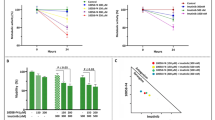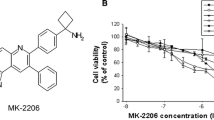Abstract
Purpose
The clinical outcome of chronic myeloid leukemia (CML) patients has been changed dramatically due to the development of imatinib (IM). However, the emergence of IM resistance, commonly associated with point mutations within the BCR-ABL kinase domain, remains a major clinical problem. Here, we investigated the effects of E35, a novel derivative of emodin, on the IM-resistant 32Dp210-T315I cells.
Methods
Cell proliferation was measured by 3-(4,5-dimethylthiazol-2-yl)-2,5 diphenyltetrazolium bromide and colony formation assay. Induction of apoptosis was confirmed by DNA fragmentation assay and annexin V/PI staining assay. Real-time quantitative PCR was used to access the BCR-ABL gene expression. Changes of related signaling molecules were detected through Western blot.
Results
E35 was found to potently inhibit proliferation of 32Dp210-T315I cells with an average IC50 of 2.4 µM at 48 h. Colony formation was almost fully suppressed in 1.0 μM E35 group. DNA fragmentation and annexin V/PI staining assay exhibited the typical DNA fragmentation and the increased proportion of early apoptotic cells, respectively. The induction of apoptosis was associated with increase of Bax to Bcl-2 expression ratio and activation of caspase cascades involving decrease of pro-caspase 9 and pro-caspase 3 and increase of PARP cleavage. The protein expression of P210BCR-ABL and p-P210BCR-ABL was down-regulated in the presence of E35, although the mRNA levels remained almost unchanged. Moreover, the activation of the P210BCR-ABL downstream signaling pathways including CrkL, Akt/mTOR and MEK/ERK was fully suppressed by E35.
Conclusion
Our study indicated that E35 might be a potential antileukemia agent against IM resistance in CML.






Similar content being viewed by others
References
Apperley JF (2007) Part I: mechanisms of resistance to imatinib in chronic myeloid leukaemia. Lancet Oncol 8(11):1018–1029. doi:10.1016/S1470-2045(07)70342-X
Branford S, Hughes TP (2011) Mutational analysis in chronic myeloid leukemia: when and what to do. Curr Opin Hematol 18(2):111–116. doi:10.1097/MOH.0b013e32834399ef
Branford S, Melo JV, Hughes TP (2009) Selecting optimal second-line tyrosine kinase inhibitor therapy for chronic myeloid leukemia patients after imatinib failure: does the BCR-ABL mutation status really matter. Blood 114(27):5426–5435. doi:10.1182/blood-2009-08-215939
Chen YY, Li J, Hu JD, Zheng J, Zheng ZH, Zhu LF, Chen XJ, Lin ZX (2013) Reversing effects of emodin on multidrug resistance in resistant HL-60/ADR cells. Zhongguo Shi Yan Xue Ye Xue Za Zhi 21(6):1413–1422
Cortes JE, Kantarjian H, Shah NP, Bixby D, Mauro MJ, Flinn I, O’Hare T, Hu S, Narasimhan NI, Rivera VM, Clackson T, Turner CD, Haluska FG, Druker BJ, Deininger MW, Talpaz M (2012) Ponatinib in refractory Philadelphia chromosome-positive leukemias. N Engl J Med 367(22):2075–2088. doi:10.1056/NEJMoa1205127
Cortes JE, Kim DW, Pinilla-Ibarz J, Le CP, Paquette R, Chuah C, Nicolini FE, Apperley JF, Khoury HJ, Talpaz M, DiPersio J, DeAngelo DJ, Abruzzese E, Rea D, Baccarani M, Muller MC, Gambacorti-Passerini C, Wong S, Lustgarten S, Rivera VM, Clackson T, Turner CD, Haluska FG, Guilhot F, Deininger MW, Hochhaus A, Hughes T, Goldman JM, Shah NP, Kantarjian H (2013) A phase 2 trial of ponatinib in Philadelphia chromosome-positive leukemias. N Engl J Med 369(19):1783–1796. doi:10.1056/NEJMoa1306494
de Jong R, Ten HJ, Heisterkamp N, Groffen J (1997) Tyrosine 207 in CRKL is the BCR/ABL phosphorylation site. Oncogene 14(5):507–513. doi:10.1038/sj.onc.1200885
Deininger MW, Goldman JM, Melo JV (2000) The molecular biology of chronic myeloid leukemia. Blood 96(10):3343–3356
Fulda S, Debatin KM (2006) Extrinsic versus intrinsic apoptosis pathways in anticancer chemotherapy. Oncogene 25(34):4798–4811. doi:10.1038/sj.onc.1209608
Guo HC, Bu HQ, Luo J, Wei WT, Liu DL, Chen H, Tong HF, Wang ZH, Wu HY, Li HH, Zuo MM, Li W, Lin SZ (2012) Emodin potentiates the antitumor effects of gemcitabine in PANC-1 pancreatic cancer xenograft model in vivo via inhibition of inhibitors of apoptosis. Int J Oncol 40(6):1849–1857. doi:10.3892/ijo.2012.1389
Hochhaus A, O’Brien SG, Guilhot F, Druker BJ, Branford S, Foroni L, Goldman JM, Muller MC, Radich JP, Rudoltz M, Mone M, Gathmann I, Hughes TP, Larson RA (2009) Six-year follow-up of patients receiving imatinib for the first-line treatment of chronic myeloid leukemia. Leukemia 23(6):1054–1061. doi:10.1038/leu.2009.38
Hu J, Lin M, Liu T, Li J, Chen B, Chen Y (2011) DIGE-based proteomic analysis identifies nucleophosmin/B23 and nucleolin C23 as over-expressed proteins in relapsed/refractory acute leukemia. Leuk Res 35(8):1087–1092. doi:10.1016/j.leukres.2011.01.010
Huang Y, Hu J, Zheng J, Li J, Wei T, Zheng Z, Chen Y (2012) Down-regulation of the PI3K/Akt signaling pathway and induction of apoptosis in CA46 Burkitt lymphoma cells by baicalin. J Exp Clin Cancer Res 31:48
Huang PH, Huang CY, Chen MC, Lee YT, Yue CH, Wang HY, Lin H (2013) Emodin and aloe–emodin suppress breast cancer cell proliferation through ER alpha inhibition. Evid Based Complement Alternat Med 2013:376123. doi:10.1155/2013/376123
Hwang JK, Noh EM, Moon SJ, Kim JM, Kwon KB, Park BH, You YO, Hwang BM, Kim HJ, Kim BS, Lee SJ, Kim JS, Lee YR (2013) Emodin suppresses inflammatory responses and joint destruction in collagen-induced arthritic mice. Rheumatology (Oxford) 52(9):1583–1591. doi:10.1093/rheumatology/ket178
Kharas MG, Janes MR, Scarfone VM, Lilly MB, Knight ZA, Shokat KM, Fruman DA (2008) Ablation of PI3K blocks BCR-ABL leukemogenesis in mice, and a dual PI3K/mTORinhibitor prevents expansion of human BCR-ABL + leukemia cells. J Clin Invest 118(9):3038–3050. doi:10.1172/JCI33337
Lahaye T, Riehm B, Berger U, Paschka P, Muller MC, Kreil S, Merx K, Schwindel U, Schoch C, Hehlmann R, Hochhaus A (2005) Response and resistance in 300 patients with BCR-ABL-positive leukemias treated with imatinib in a single center: a 4.5-year follow-up. Cancer 103(8):1659–1669. doi:10.1002/cncr.20922
Mahon FX, Deininger MW, Schultheis B, Chabrol J, Reiffers J, Goldman JM, Melo JV (2000) Selection and characterization of BCR-ABL positive cell lines with differential sensitivity to the tyrosine kinase inhibitor STI571: diverse mechanisms of resistance. Blood 96(3):1070–1079
Nambu T, Araki N, Nakagawa A, Kuniyasu A, Kawaguchi T, Hamada A, Saito H (2010) Contribution of BCR-ABL-independent activation of ERK1/2 to acquired imatinib resistance in K562 chronic myeloid leukemia cells. Cancer Sci 101(1):137–142. doi:10.1111/j.1349-7006.2009.01365.x
O’Hare T, Walters DK, Stoffregen EP, Jia T, Manley PW, Mestan J, Cowan-Jacob SW, Lee FY, Heinrich MC, Deininger MW, Druker BJ (2005) In vitro activity of Bcr-Abl inhibitors AMN107 and BMS-354825 against clinically relevant imatinib-resistant Abl kinase domain mutants. Cancer Res 65(11):4500–4505. doi:10.1158/0008-5472.CAN-05-0259
Oltvai ZN, Milliman CL, Korsmeyer SJ (1993) Bcl-2 heterodimerizes in vivo with a conserved homolog, Bax, that accelerates programmed cell death. Cell 74(4):609–619. doi:10.1016/0092-8674(93)90509-O
Qiu B, Li J, Chen C, Chen Y, Hu J, Yuan Y, Wang W (2010) Synthesis of soluble emodin derivatives and their effects on proliferation inhibition in leukemic cell lines. Chin J Med Chem 20:353–357
Quentmeier H, Eberth S, Romani J, Zaborski M, Drexler HG (2011) BCR-ABL1-independent PI3Kinase activation causing imatinib-resistance. J Hematol Oncol 4(6). doi:10.1186/1756-8722-4-6
Quintas-Cardama A, Cortes J (2008) Therapeutic options against BCR-ABL1 T315I-positive chronic myelogenous leukemia. Clin Cancer Res 14(14):4392–4399. doi:10.1158/1078-0432.CCR-08-0117
Salgia R, Pisick E, Sattler M, Li JL, Uemura N, Wong WK, Burky SA, Hirai H, Chen LB, Griffin JD (1996) p130CAS forms a signaling complex with the adapter protein CRKL in hematopoietic cells transformed by the BCR/ABL oncogene. J Biol Chem 271(41):25198–25203. doi:10.1074/jbc.271.41.25198
Santos FP, Kantarjian H, Quintas-Cardama A, Cortes J (2011) Evolution of therapies for chronic myelogenous leukemia. Cancer J 17(6):465–476. doi:10.1097/PPO.0b013e31823dec8d
Shah NP, Tran C, Lee FY, Chen P, Norris D, Sawyers CL (2004) Overriding imatinib resistance with a novel ABL kinase inhibitor. Science 305(5682):399–401. doi:10.1126/science.1099480
Shrimali D, Shanmugam MK, Kumar AP, Zhang J, Tan BK, Ahn KS, Sethi G (2013) Targeted abrogation of diverse signal transduction cascades by emodin for the treatment of inflammatory disorders and cancer. Cancer Lett 341(2):139–149. doi:10.1016/j.canlet.2013.08.023
Stoetzer OJ, Nussler V, Darsow M, Gullis E, Pelka-Fleischer R, Scheel U, Wilmanns W (1996) Association of bcl-2, bax, bcl-xL and interleukin-1 beta-converting enzyme expression with initial response to chemotherapy in acute myeloid leukemia. Leukemia 10(Suppl 3):S18–S22
Su YJ, Tsai MS, Kuo YH, Chiu YF, Cheng CM, Lin ST, Lin YW (2010) Role of Rad51 down-regulation and extracellular signal-regulated kinases 1 and 2 inactivation in emodin and mitomycin C-induced synergistic cytotoxicity in human non-small-cell lung cancer cells. Mol Pharmacol 77(4):633–643. doi:10.1124/mol.109.061887
Subramaniam A, Shanmugam MK, Ong TH, Li F, Perumal E, Chen L, Vali S, Abbasi T, Kapoor S, Ahn KS, Kumar AP, Hui KM, Sethi G (2013) Emodin inhibits growth and induces apoptosis in an orthotopic hepatocellular carcinoma model by blocking activation of STAT3. Br J Pharmacol 170(4):807–821. doi:10.1111/bph.12302
Suzuki M, Abe A, Imagama S, Nomura Y, Tanizaki R, Minami Y, Hayakawa F, Ito Y, Katsumi A, Yamamoto K, Emi N, Kiyoi H, Naoe T (2010) BCR-ABL-independent and RAS/MAPK pathway-dependent form of imatinib resistance in Ph-positive acute lymphoblastic leukemia cell line with activation of EphB4. Eur J Haematol 84(3):229–238. doi:10.1111/j.1600-0609.2009.01387.x
Thomas J, Wang L, Clark RE, Pirmohamed M (2004) Active transport of imatinib into and out of cells: implications for drug resistance. Blood 104(12):3739–3745. doi:10.1182/blood-2003-12-4276
Tian Q, Stepaniants SB, Mao M, Weng L, Feetham MC, Doyle MJ, Yi EC, Dai H, Thorsson V, Eng J, Goodlett D, Berger JP, Gunter B, Linseley PS, Stoughton RB, Aebersold R, Collins SJ, Hanlon WA, Hood LE (2004) Integrated genomic and proteomic analyses of gene expression in mammalian cells. Mol Cell Proteomics 3(10):960–969. doi:10.1074/mcp.M400055-MCP200
Wei TN, Hu JD, Chen YY, Chen XJ, Liu TB, Lu LH (2009) Effect of emodin on induction of apoptosis in jurkat cells and its possible mechanisms. Zhongguo Shi Yan Xue Ye Xue Za Zhi 17(5):1203–1206
Wu L, Cai B, Zheng S, Liu X, Cai H, Li H (2013) Effect of emodin on endoplasmic reticulum stress in rats with severe acute pancreatitis. Inflammation 36(5):1020–1029. doi:10.1007/s10753-013-9634-y
Zheng HY, Hu JD, Zheng ZH, Huang LY, Chen YY, Zheng J, Chen XJ, Lu LH (2007) Emodin induces leukemic HL-60 cells apoptosis probably by inhibiting Akt signal pathway. Yao Xue Xue Bao 42(11):1142–1146
Zheng ZH, Hu JD, Chen YY, Lian XL, Zheng HY, Zheng J, Lin MH (2009) Effect of emodin on proliferation inhibition and apoptosis induction in leukemic K562 cells. Zhongguo Shi Yan Xue Ye Xue Za Zhi 17(6):1434–1438
Acknowledgments
This work was supported by National and Fujian Provincial Key Clinical Specialty Discipline Construction Program, China, National High Technology Research and Development Program of China, 863 program (2012AA02A505), National Public Health Grand Research Foundation (201202017), the Specialized Research Fund for the Doctoral Program of Higher Education of China (20103518110003), Fujian Provincial Natural Science Foundation (2012J01353) and Youth Foundation of Fujian Provincial Health Bureau (2010-2-15).
Conflict of interest
The authors declare that there is no conflict of interest.
Author information
Authors and Affiliations
Corresponding author
Additional information
Jing Li and Yingyu Chen have contributed equally to this work.
Rights and permissions
About this article
Cite this article
Li, J., Chen, Y., Chen, B. et al. Inhibition of 32Dp210 cells harboring T315I mutation by a novel derivative of emodin correlates with down-regulation of BCR-ABL and its downstream signaling pathways. J Cancer Res Clin Oncol 141, 283–293 (2015). https://doi.org/10.1007/s00432-014-1820-2
Received:
Accepted:
Published:
Issue Date:
DOI: https://doi.org/10.1007/s00432-014-1820-2




